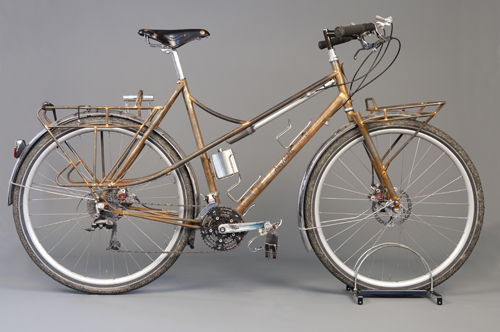 Mixte Touring 29er
Mixte Touring 29er
“What is this thing?!”
This past October at the Oregon Bicycle Builders’ Show, Jonathan Maus of bikeportland.org stopped by the booth and was looking at this crazy bike of mine. I tried to sum it up as succinctly as possible: “It’s a mixte off road touring 29er commuter monster truck thing, with a flask cage.” Something like that.
The bike was hanging on a stand at the back of my booth. I’d been riding it for a couple of months without paint, and it had a nice patina of rust going. When Jonathan was done taking in all that information the only question he could think to ask was, “Why?” The only proper answer to that is, “Because I can.”
flickr slideshow
This is one of those projects that has been on my mind for a long time. The frame design is a nod to Jeff Jones’ ‘Space Frame,’ but has a completely different function as a bike. I was looking for the stand over height allowed by the mixte design, and I wanted to be able to tour on the bike. Also, it needed clearance for fat tires and fenders, because that’s what I like.
As a touring bike, it needed to be comfortable and have plenty of stuff-carrying capabilities. Also a pump and plenty of bottle cages. And I wanted a detachable spork head tube badge. The back end of the bike is especially long to accommodate fat tires, fenders, and so panniers could be relatively centered over the rear axle. For commuting purposes I also included a simple lock holster on the rear rack.
The front rack is brazed directly to the fork. If you know the rack is always meant to be with the bike, and so long as it doesn’t interfere with brake adjustments or anything like that, then it makes sense to have the rack as a permanent fixture. It is the strongest, lightest way to build a rack. The front rack also has an integrated light mount and internal routing for the light wire to go to the generator hub.
This past summer, before having the bike powder coated I rode it out to Astoria and down the coast to Newport, about 250 miles. I went with a few friends, and we took gear to camp along the way. All in all, the bike performed really well. It was incredibly comfortable, and I felt like I could stay in the saddle all day without issue. The handling was sure, and especially on the unpaved parts of the Banks/Vernonia Trail, the bike was perfect for the job.
The only problem I discovered was, with the bike loaded down and while up out of the saddle there was noticeable flex at the back end. If there was one thing I would change about the design, it would be that I would use the stouter version of the rear dropouts. I used the “Low mount disc dropouts” by Paragon Machine Works. There are two versions of these dropouts; the lighter set with cut-outs; and the heavier, thicker version without cutouts. I used the lighter version. There is always going to be a noticeable difference when a lot of weight is on the back end of a bike, but I think some of the flex could have been prevented.
Overall, as an experiment, the bike has been a success. I really enjoy projects like these because it gives me a chance to think things through and test some of my theories about what works and what doesn’t. And besides, look at this thing! For those of us out there who like to sit and stare at our bikes just because they’re sexy, cool, interesting, ingenious, beautiful -- not to mention that they’re really smart inventions -- this one begs to be given a little extra time.
Enjoy!
